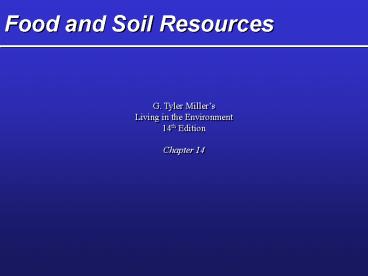Food and Soil Resources - PowerPoint PPT Presentation
1 / 25
Title:
Food and Soil Resources
Description:
Selectively bred or genetically-engineered crops. High inputs of fertilizer ... or carp) 2. Fig. 14-22 p. 297. Catching and Raising More Fish. Fisheries ... – PowerPoint PPT presentation
Number of Views:72
Avg rating:3.0/5.0
Title: Food and Soil Resources
1
Food and Soil Resources
G. Tyler Millers Living in the Environment 14th
Edition Chapter 14
2
Key Concepts
- Methods of producing food
- Increasing food production
- Soil degradation
- Increasing sustainability
3
How Is Food Produced?
- Sources of food
- Primary plantswheat, corn, and rice
- Primary animalsfish, beef, pork, and chicken
4
Major Types of Agriculture
- Industrialized agriculture
- Plantation
- Traditional subsistence agriculture
- Traditional intensive agriculture
5
World Food Production
Fig. 14-2 p. 275
6
Producing Food by Green-Revolution Techniques
- High-input monoculture
- Selectively bred or genetically-engineered crops
- High inputs of fertilizer
- Extensive use of pesticides
- High inputs of water
- Multiple cropping
7
Green Revolutions
Fig. 14-4 p. 277
8
Producing Food by Traditional Techniques
- Interplanting
- Polyvarietal cultivation
- Intercropping
- Agroforestry (alley cropping)
- Polyculture
See Individuals Matter p. 279
9
Causes of Soil Erosion
- Wind
- Water
- People
10
Global Soil Erosion
Fig. 14-7 p. 280
11
Soil Erosion in the US
- Dust Bowl 1930s Fig. 14-5 p. 281
- Reductions in erosion since 1987
- 1985 Food Security Act
12
Causes of Desertification
- Overgrazing
- Deforestation
- Erosion
- Salinization
- Soil Compaction
- Natural Climate Change
Refer to Fig. 14-10 p. 283
13
World Desertification
Fig. 14-9 p. 282
14
Soil Degradation on Irrigated Land
- Salinization
- Waterlogging
Fig. 14-11 p. 283
15
Reducing and Cleaning Up Salinization
- Reduce irrigation
- Switch to salt-tolerant crops
- Flush soils
- Not growing crops for 2-5 years
- Install underground drainage
Refer to Fig. 14-12 p. 283
16
Solutions Soil Conservation
- Conventional-tillage
- Conservation tillage
- Terracing
Refer to Fig. 14-14 p. 285
- Contour farming
- Strip and alley cropping
- Windbreaks
- Land Classification
17
Soil Restoration
- Organic fertilizer
- Animal manure
- Green manure
- Compost
- Crop rotation
- Commercial inorganic fertilizer
18
World Food Production
- Now leveling off
- Shortages in developing countries
Fig. 14-16 p. 287
19
Nutrition
- Undernutrition
- Malnutrition
- Overnutrition
Refer to Fig. 14-17 p. 288
20
Environmental Effects of Food Production
- Biodiversity loss
- Soil degradation
- Air pollution
See Fig. 14-18 p. 290
- Water shortages and erosion
- Human health
21
Increasing World Crop Production
- Crossbreeding and artificial selection
- Genetic engineering (gene splicing)
- Genetically modified organisms (GMOs)
- Continued Green Revolution techniques
- Introducing new foods
- Working more land
22
Producing More Meat
- Feedlots
- Rangelands
- Efficiency
Fig. 14-22 p. 297
- Improved rangeland management
- Environmental consequences (Connections p. 295)
23
Catching and Raising More Fish
- Fisheries
- Fishing methods (See Fig. 14-24 p. 299)
- Overfishing
- Commercial extinction
- Aquiculture
- Fish farming and ranching
24
Government Agricultural Policy
- Artificially low prices
- Subsidies
- Elimination of price controls
- Food aid
25
Solutions Sustainable Agriculture
- Low-input agriculture
- Organic farming
See Fig. 14-29 p. 302
- Profitable
- Increasing funding for research in sustainable
techniques

